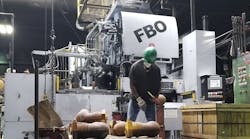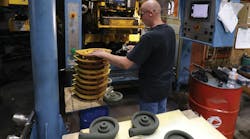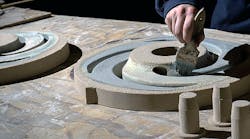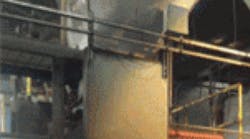Coolidge, TX, is midway between Dallas and Houston, but with a population of less than 1,000 it’s a long way from the big cities. American small towns are not immune to change, though, so while much remains recognizably old-fashioned here – much is modernizing, too. That is especially so for Frazier & Frazier Industries, a 40-year-old ductile and gray iron foundry.
Established in 1972 by C.W. Frazier as a traditional cope-and-drag sand casting operation with two squeezers, today’s F&F is a more flexible operation. In recognition of the industrial landscape, it’s an ISO 9002-certified operation that aims to retain what’s best about older ways of doing business even as it adopts newer casting equipment and technology. As plant manager Will Frazier pointed out, “This is one of the biggest reasons we’ve continued to prosper, while so many other foundries have disappeared. We recognize what works and what doesn’t, to best suit our current business and market conditions.”
Once devoted to large-volume order production, F&F today continues to support those types of customers but it has reshaped its business model in several ways. “We have traditionally worked in pieces from a few ounces up to 150 lb., or more,” Frazier explained. “The large runs were more typical in days past; we saw a new business environment emerging several years ago, when the market began to decline overall.”
Frazier detailed that many of the foundry’s traditional customers began to reduce their inventories, in order to save on purchasing costs, and placed shorter-run orders — but with much shorter, and more demanding, lead times. These factors increased job numbers and made shipping requirements more of a challenge, and ultimately changed the pace of business at F&F. “It’s not unusual for us to come in on a Sunday to finish a job for a customer who really needs it,” Frazier noted, hinting at one way that an older style of doing business continues to keep the foundry competitive in the changing market. “And, we rarely charge a premium, because we know how tough things are for most of our accounts,” he added.
Frazier & Frazier also offers CNC machining, heat treating, and galvanizing services, and it has a fully outfitted qualityinspection department, including CMM and other state-of-the-art lab technologies.
While the oil-and-gas market applications are prominent among its accounts, as they are for most foundries in the region, F&F also is selling castings to manufacturers who supply customers in automotive, agricultural, wind energy, municipal water works, and other market segments, too. This strategy has helped to maintain a better balance in F&F’s workload. With its own sales force plus several manufacturers’ rep organizations in the field, Frazier & Frazier is able to count customers in a range of markets and as far away as Indiana. Geographic range like that is relatively rare in the today’s metalcasting business, especially if larger, heavier castings are involved.
With over 8,000 patterns in store, F&F is carrying out up to 15 pattern changes per day per molding machine. This complicates job scheduling and work flow, and Frazier and his colleagues — general manager Bob Pranger and v.p. of sales Harlon Easton — quickly recognized that they needed more automation in their machinery options.
F&F continues to prepare molds with hand-rammed and air-set cores, but over the years it has acquired automatic coresetting equipment and automated molding machines. The latter includes F&F’s most recent purchase, a Hunter Automated Machinery XL2024 automatic matchplate molding machine, which like other molding machines there is used with a Hunter mold-handling turntable system. Three melting furnaces deliver certified chemically correct iron to the molding stations. Currently, F&F reports that approximately 70% of its work is cast as ASTM Class 60-100 ductile iron, and 30% is Class 15-50 gray iron.
The XL2024 is a fully automated matchplate system, using the gravity-fill technology pioneered by Hunter. It produces sand molds up to 2024 in., with a shallow 6.6-in. cope and 5.5-in. drag (165 mm/140 mm) at 180 cycles per hour, using 400 lb. (181kg) of sand. Variable-squeeze surface pressures to 142 psi (10kg/cm2) can be achieved in production.
This latest Hunter machine continues a Frazier & Frazier tradition of deploying advanced sand casting technology. Although several generations of Hunter and other brands of molding machinery have been used here, when a new machine was needed Will Frazier noted that the foundry identified some essential criteria. “We’d been having critical problems with another machine builder, getting parts and service. We always knew the Hunter folks were excellent in those areas based on past experience, plus they were willing to provide considerable application engineering assistance and set-up help with the new machine. Coupling that with their stability as a company and great reputation in the world foundry market, we looked at all our options and settled on the XL2024.” Frazier also complimented the supplier’s customer service efforts. “Mike Hughes came down here several times to help us,” he said of Hunter’s sales/service manager, “and since the machine has been up and running he’s stayed in close touch with us, even though we’ve had no performance issues with the machine.”









